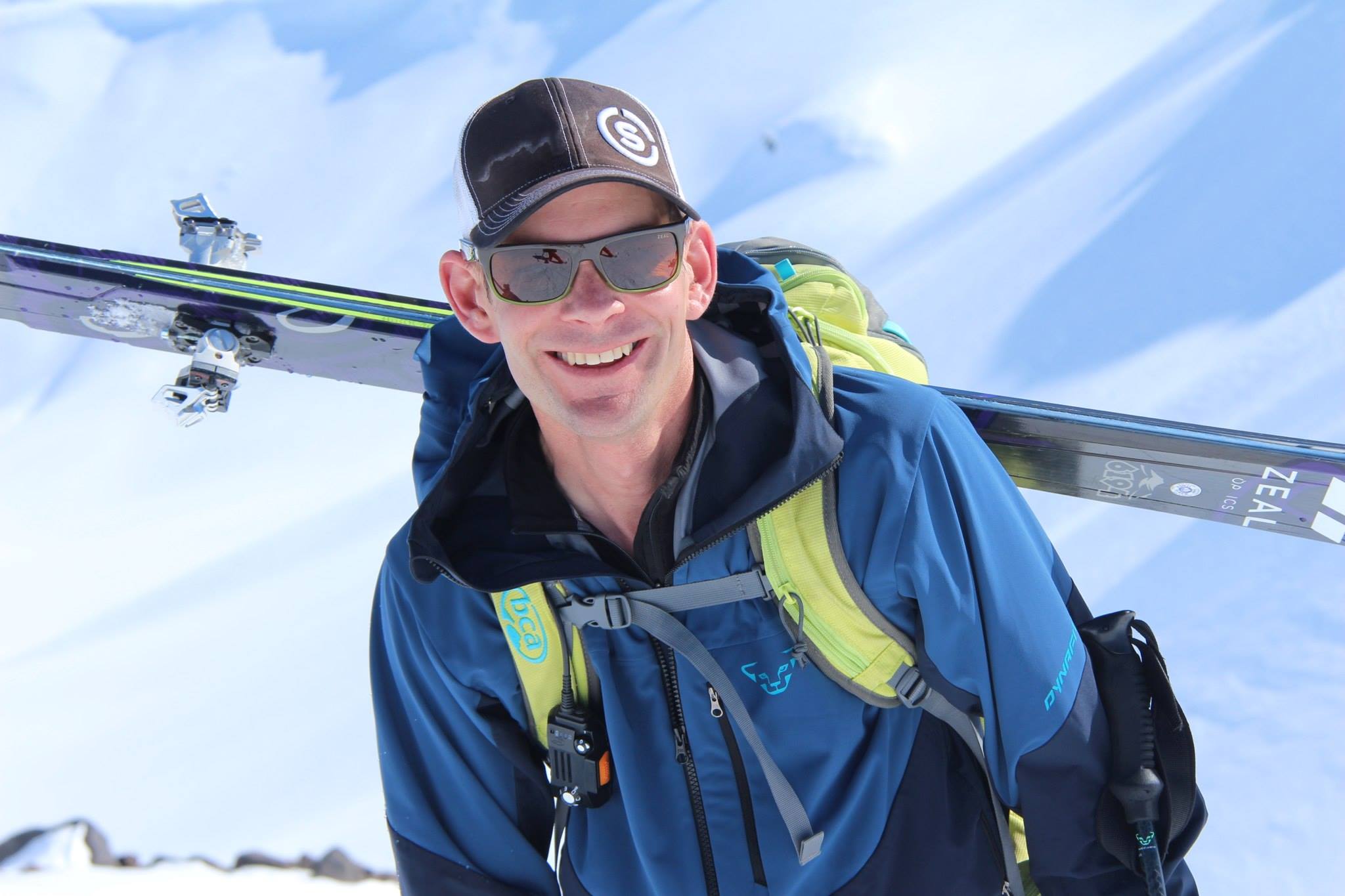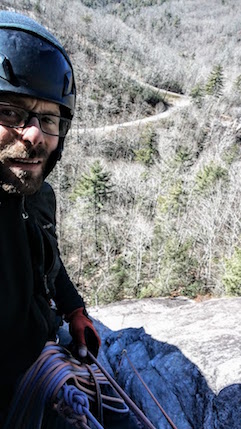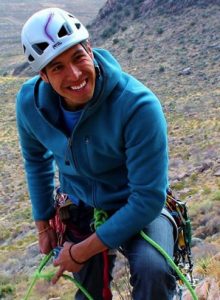A Letter From Rob Hess, AMGA Board President
Dear AMGA Members,
As the fall AMGA Annual Meeting and meeting of the Board of Directors draws closer, I wanted to take some time to discuss the state of affairs at the AMGA. In particular, the reasons, chronology of events and thought process behind the Scope of practice initiative and the timeline for its implementation as discussed by the board.
I often hear comments regarding access in the US and the comparison to access in Europe. These comments range from wondering why there can’t be open and unrestricted credential based access to public lands in the US as is the case in Europe, to the idea that the current permit structure is fine and working within this structure is in the best interest of the preservation of the natural resource. For most of us, I believe the sentiment is that the current permit structure is riddled with problems and does not allow for the most progressive use of our public lands. I also believe that the land agencies must believe that working with guides on public lands is to better take care of the resource.
When debating issues, we must be mindful of the long history of how our public lands have been managed over the last 100 plus years. Public lands in the US are wild and much less developed and far less trammeled than many places around the world. Preservation of our uniquely American public lands resource is, in my opinion, essential to the wellness of current and future generations. If we allow this to be compromised then we risk what many politicians are in favor of: selling the lands off to the highest bidder. I think that we tend to compare all the best things about guiding in Europe to all the worst things about guiding in the US. So when we ask to have things be just like Europe regarding access, I think we first need to look deep into our own conscience at the pristine nature of our public lands and ask… do we really want access in the US to be just like Europe?
I am not sure we really want things to be just like Europe, but is there some form of process or evolution of thought that could allow for a model where certified mountain guides could have fair and equal access to public lands? Yes, I do believe there is.
There has been much discussion on the various AMGA mountain guiding blogs regarding the direction of the AMGA, its transparency and the reasons for what is happening. These blogs are essential and people must have a forum to discuss issues, present concerns, frustrations and hopefully in the end, create a dialogue that will help further the AMGA in a positive and constructive way. The Technical Director and I have chimed in to a degree, but for the most part have let the discussion role without comment. Where it is important for us to have this dialogue amongst ourselves, it is clear that we must also do so in a respectful and productive manner. I often wonder if folks commenting have a thorough understanding of how and why decisions have been made, which leads me to believe that our communication could have been clearer. As the annual meeting comes closer I think it is essential to make sure our membership have as clear an understanding of what is happening as possible and why.
The thoughts and opinions regarding training and certification and its role in regards to access have been a discussion since the beginning of the AMGA. The passion and intensity of the discussion has varied with time, but it seems that the intensity has increased in the past three years. To better meet the needs of the certified and aspiring guide membership, the board resolved to rework accreditation to more definitively connect the use of certified and aspiring guides by employers accredited by the AMGA. “The Accreditation Program underwent significant change in 2013 with the BOD adoption of the new accreditation standard that requires all field staff working for an AMGA Accredited Business to be trained by the AMGA for the terrain that they work on. The new standard was to be effective January 1, 2017. An exemption to the standard was granted to employees hired by an accredited business prior to January 1, 2008.” This standard was until recently referred to as the “Training and Supervision guidelines”.
The accreditation based access model was a concept also discussed by the board as a measure the board felt had real potential to be adopted over time by land agencies. The premise of the model essentially requires all mountain guiding businesses that use public lands be accredited by the AMGA, and to be accredited you have to employ certified guides and or guides in the training process, possess insurance, operating plans, risk management plans, emergency response plans and so on. With this model, terrain and supervision guidelines would apply to all accredited businesses and would require all companies that are accredited to abide by the terrain and supervision guidelines. To be clear on this, the intention was that accreditation was to be applied to individuals (a company of one person) up through all sizes of companies. As a result of this discussion the Board directed the Advocacy Director at the time, to work with the Advocacy Committee to devise a road map of how the AMGA might accomplish the advocacy goal of accreditation based access and whether it was feasible. In conjunction with this goal, access for AMGA training and certification programs and foreign IFMGA guides was listed as a high priority.
The measure that requires all field staff working for an AMGA Accredited Business to be trained by the AMGA for the terrain that they work on is critical. However, the 2017 deadline turned out to be unrealistic. The AMGA simply could not train enough guides to meet the deadline. Furthermore, when the AMGA voted on the terrain and supervision guidelines and the deadline, we had not vetted either the guidelines nor the deadline with all of the stakeholders including enough guides, Accredited firms, legal council or land managers. In other words, in our effort to establish the guidelines quickly, we had not considered many issues that turned out to be critical to a successful implementation.
The subsequent research done on behalf of the AMGA clarified several of these implementation issues. The most important was the AMGA’s inability to accommodate the number of guides that would need courses and exams to meet the 2017 date. Because we could not train enough guides, both current Accredited firms and potential new guide services could not support the initiative. Currently the AMGA has approximately 33 accredited businesses, and should we ever get to the point where all businesses need to be accredited to have access to public lands, the number of Accredited firms would increase by a factor of 10 to more than 300! Our training and certification programs have grown by 40% last year and we look to be growing by 60% this year, which is placing considerable demand on the Technical Branch to the point where we are beginning to worry about the potential impact on course quality and risk management. Given the existing stress on our system, its hard to imagine the AMGA accommodating the need that would be generated if accreditation based access were achieved in the short, or even medium term.
For this reason, the Board of Directors decided that we should enhance the terrain and supervision guidelines so that we would be successful making sure that guides working for Accredited Firms would in fact be trained on the terrain that they are guiding on. We also came to the conclusion that driving accreditation-based access as the standard for access to public lands is something that can not be considered until after there are enough guides trained to work on such land. Accreditation remains a voluntary process. Perhaps a model of enhanced access based on accreditation might be a workable model in the near future, which simply states that an accredited business is looked upon more favorably when seeking access to public lands.
The question that has been a source of heated debate and one that served to polarize the guiding community was the question of all accredited companies abiding by the terrain and supervision guidelines by the 2017 deadline. One side of the debate stated that it was not possible to meet the terrain and supervision guidelines by 2017 due to a lack of courses to meet the demand and or a lack of available guides trained by the AMGA. Other concerns that were stated were no flexibility, programs don’t meet needs, conflicts with course scheduling and offerings, cost, transferability of exempt guides, foreign employees, impacts on hiring, role of exempt guides, changing leadership (of AMGA board). The other side of the debate suggested that: “accredited companies have dragged their feet for long enough and it is high time they put up or shut up.” It was also felt that the AMGA has a history of not following through with its initiatives, all of which amounted to the desire to keep the deadline at 2017!” A third debate emerged that suggested that individual members of the AMGA should be personally responsible for meeting the terrain and supervision guidelines as a condition of membership. The polarization deepened with the now famous meeting of 9 prominent AMGA accredited guiding companies in Seattle to explore other options for accreditation given the demands of the terrain and supervision guidelines and the perceived inability of the companies to meet the 2017 deadline. As I came on as President of the Board, the polarization of the AMGA community was about as deep as I have seen in quite some time. To further the polarization, it was requested that the 2017 deadline be postponed. It was crystal clear to me that something needed to be done to begin to bring the various entities in the AMGA back in line with each other else we were, in my opinion, looking at very hard times as an organization for years to come.
The AMGA consists of well over 3000 members ranging from IFMGA guides to Climbing Wall instructors and includes numerous sizes of guiding businesses. With the total number of somewhere in the low 100’s, IFMGA guides have put forth the most amount of energy to get where they are with the AMGA, but there are still many forms of guides that are passionate about the pursuit and very important to the organization. In other words, there are many forms of stakeholders at the AMGA. As an organization we all need each other. The process of becoming a certified guide is lengthy and requires personal as well as professional development. Mentoring, practical application, training and real world experience are all key to becoming a top tier guide. There are those who choose to work independently and there are those who choose to work for various organizations or some combination of the two. In most cases, guides start by working for a guiding company or outdoor education organization to start gaining that mentoring and real world experience they need to become a great guide. In some cases the independent guide can be quite successful in mentoring and developing guides, but this does not account for the greater numbers of guides working to become certified guides.
As an organization of 3000 plus members and growing, if we are to be successful gaining access to the public lands that we desire, we must show that we are organized and willing to work together. Internal debate and discussion is to be expected, but compromise and willingness to work together for the good of the organization is the only way to be successful. An organization that is fractionalized by differing agendas will send a poor message to land managers when we are lobbying for better guiding access for all our members and hamper our ability to be successful.
It was my feeling as President that we could and needed to keep the 2017 deadline in tact, but I also felt that there was a way to address the concerns on both sides of the debate such that both sides’ real concerns could be accommodated. It was also my feeling that we did not want to lose members and/or accredited businesses as a result of this dissention.
During the October 2014 Board meeting, the Board decided that the AMGA needed to take a hard look at the terrain and supervision guideline model and decide what if anything should be done about the 2017 deadline. An Ad HOC Advocacy Committee, chaired by Dan Nordstrom, was formed to generate some tangible ideas and direction for where to go with the issues of the terrain and supervision guidelines and the 2017 deadline. On December 30th 2014, Dan and I met in Jackson Wyoming to hash out some ideas regarding these issues. Dan and I came up with a plan we felt might address the concerns on both sides of the debate. We felt that if we could bring together a group of guides and guide companies in a face to face meeting that represented a diverse cross section of opinions, ideologies, regional and operational scope, that we might be able to come up with a workable solution on how to advise the board to move forward with the terrain and supervision guidelines deadline and debate.
In January of 2015 Dan and I brought a proposal to the board to form a terrain and supervision guidelines committee and to allocate funds to hire a professional facilitator to guide discussion and debate in a 2-day face-to-face meeting, which came to be known as the “Terrain and Supervision Guidelines Summit”. The goal of the meeting was to make significant progress towards a framework agreement on key decisions for possible amendments to the Terrain and Supervision Guidelines. The board agreed upon the proposal and we then gathered a group of individuals we felt represented diverse opinions in the guiding community and individuals we felt would engage in a respectful and productive meeting.
Voting members of the review team were: Bill Allen, Mark Allen, Elaina Arenz, myself (Rob Hess), Paul Maier, Marty Molioris, Nat Patridge, Dale Remsberg, Silas Rossi, Dylan Taylor and Geoff Unger, with Ed Crothers (office representative) Dan Nordstrom (Board) and Whitney Wheeless (outside consultant) also present as facilitators.
The committee met on May 7th and 8th in a remote lodge on the Bridger Teton National Forest. “Every aspect of the current Terrain and Supervision Guideline document was reviewed and discussed in detail. At all times the overarching goal was to develop a framework that supported the goal of assuring that guides work in terrain for which they are trained. At the same time a parallel goal was to devise a product that works for all AMGA members and guide services. Everyone was cognizant of the divisive situation that arose in 2014 and realized that their job was to find the best answer for the entire AMGA community”.
This meeting will, in my opinion, be looked back upon as a landmark meeting, as all members of a very diverse group of mountain guides were able to come to the table, noting distinct differences in opinion and hash out a plan that was met with unanimous agreement. This will hopefully be a key step toward bringing fractionalized elements of the AMGA back in line. The key decisions made at the meeting were:
- Name of Document
The Review Team agreed that the Terrain and Supervision Guidelines should be renamed “Scope of Practice” to better reflect the intent of the document.
- Training Timeline
The Review Team agreed that the requirement for further training, as defined in Section V, should be eliminated. In addition, the training timeframes (the time period allowed between courses and exams) should be specified within the training and certification programs. The requirements for continuing professional development will need to be defined for guides not continuing on the certification track.
- Mid-Level Credentials
To account for unique needs of American guiding, the Review Team agreed to the addition of two mid-level credentials-Ice Instructor and Glacier Guide.
The first decision was to add an Ice Instructor Exam with AMGA Certification. Ice terrain was generally defined as ice cragging without avalanche hazard in a non-alpine environment. Sample routes included in this terrain are 1-3 pitch routes, Ouray Ice Park, and roadside East Coast ice climbing. The Ice Instructor Exam is intended to be taken after the Ice Instructor Course and any specified prerequisites.
The second decision was to add a Glacier Guide Exam with AMGA Certification. Glaciated terrain would be narrowly defined and is generally characterized by advanced rope handling, minimal short roping, and moderate alpine ice. Example routes in this terrain include the Disappointment Cleaver on Rainer, Coleman Deming on Mt Baker , and the West Buttress on Denali. The Glacier Guide Exam would likely be a 10-day course structured similar to the Advanced Alpine Guide Course with 6 days of instruction and 4 days for the exam. The Alpine Skills Course and the Alpine Guide Course are prerequisites for the Glacier Guide Exam. Additional prerequisites for the exam will need to be defined and will include guiding experience, avalanche training and mentoring components.
For both of these new credentials, the Technical Director will need to define the terrain and the supervision requirements that will be added to the Scope of Practice. Additionally, the Technical Committee will need to create the curriculum for the Glacier Guide Exam and the Ice Instructor Exam. The current curriculum for the Alpine Skills and Alpine Guide Courses will be adjusted to incorporate critical components for glaciated terrain and enhanced navigation skills. Please keep in mind that for these programs to be successful the Scope of Practice needs to be in place and adhered to.
- Implementation Schedule
The Review Team agreed to proceed with the 2017 implementation date of the Scope of Practice and add in flexibility with a phased approach. For accredited businesses, the percentage of guides (including 2008 tenured guides) that are adhering to the Scope of Practice should comply with the following schedule:
by 1/1/2017: 50% of guides are operating within the Scope of Practice
1/1/2018: 60%
1/1/2019: 70%
1/1/2020: 80%
1/1/2021: 90%
1/1/2022: 100%
- Application of the Scope of Practice
The Review Team recommended that the Board consider applying the Scope of Practice to the entire membership of the AMGA as a condition of membership. This would include accredited businesses and individual AMGA members. For the timeline, the Review Team felt that by 1/1/2022, all individual AMGA members should be adhering to the Scope of Practice.
- Documentation Requirements
The Review Team agreed to remove the burdensome requirements defined in the guidelines for documenting supervision. It was suggested that the AMGA develop and incorporate a logbook into the training and certification programs curriculum for guides to record their climbing, guiding, and training. This can serve as documentation for the prerequisites in the programs.
The findings of the Terrain and Supervision Guidelines review committee were brought to the Board in June 2015, the details of the meeting in regards to the committee recommendations and what the board resolved to do were as follows:
- The Board unanimously voted that “Terrain and Supervision Guidelines” would now be referred to as “Scope Of Practice”.
- The Board reached a majority consensus in favor of the 2017 deadline and the phased in approach. A plan detailing the direction to move forward in is:
- Extend Scope of Practice to entire membership (individuals and accredited businesses.)
- Define new terrain (ice instructor and glacier guide) and supervision requirements for Scope of Practice.
- Revise Scope of Practice to remove training timeline, documentation requirements, and adjust the implementation dates based on the Review Team decisions.
- Hire recreational use legal specialist to draft language that is legally sound and avoids potential liability pitfalls for guide services and individual guides and incorporates preamble on intent of the Scope of Practice document.
- Work with Technical Committee to approve and adjust the training and certification programs based on these recommendations prior to the October board meeting.
- Changes to Alpine Skills Course and Alpine Guide Course to incorporate glacier terrain and enhance navigation components
- Requirements for Glacier Guide Exam, including mentoring and experience prerequisites
- Requirements for Ice Instructor Exam
- Addition of logbook for guide log, climbing log, and training log to be kept by individual guides as part of the training and certification programs
- Send revised Scope of Practice to Review Team for review by August 2015.
- Complete final changes to the Scope of Practice.
- Present final Scope of Practice for ratification at the October board meeting.
There were elements of the recommendations I would have liked to see be different such as the time line for the phase in. There is a part of me that wants the phase in to happen much quicker but this is just my opinion and of course there are many views on this subject, but the reality of the situation suggests quicker is not feasible. There is concern regarding the phase in and many are asking what is keeping a different Board and leadership from pushing back the 2022 deadline as is now happening with the 2017 deadline. The facts are pretty clear that our carrying capacity for offering courses and exams will not support a 2017 deadline and I believe that, though it was a compromise of the time line, it is reasonable. In other words, this board pushed back the deadline for clear operational reasons. We are on a path to solve those issues so there should be no reason for the 2022 deadline to be pushed back. The board, and any future board, will be made up of people who you vote for and who are appointed by the people that you vote for. They will have a duty to uphold decisions of past boards unless they have real and substantive reasons to change direction. Even though I believe that future boards will not change the dates, I have introduced a measure that would require a super majority vote by the Board to overturn the 2022 timeline, to make it even more difficult to change the date at some future time.
The changes, updates and amendments to the Scope of Practice document have been moving forward. The document has had intensive review by counsel and there has been a great deal of work done by many on this document. Getting this document right is critical and has turned out to be a much more difficult job than expected. Where it was our goal to have the document ready for ratification by the October board meeting, the language will not be complete (because the language must stand up to legal review). It is clear that we want the board to vote on the actual because the document will direct our organization for some time to come. We are making every effort to complete this document by the annual meeting but it looks like we will have a draft version available by then for the board to review. If that is the case, we will ratify the final Scope of Practice document during the January 2016 board meeting.
With the Scope of practice document getting close to completion, it is now time to take a hard look at accreditation. There are those that feel there is minimal benefit from being accredited by the AMGA and as a result many companies that support training and certification are not accredited. As well, organizations that have been accredited are questioning whether it is a benefit to be accredited; in some cases prominent companies have withdrawn from accreditation. Some say we should drop accreditation all together, but many have put a great deal into accreditation and, in some cases, it is a permit requirement from certain land managers. This all says to me that, though accreditation may have some issues, we should not drop accreditation but take a hard look at its structure and rebuild it to give benefit to all levels of companies and organizations. Accreditation can and should be a vehicle for enhanced access and support for our members, but training and certification must be an integral part of its structure. We can make this be a system that enhances access, insures advocacy, as well as promotes an additional level of quality control for the consumer, all of which adds up to better wages and respect for the profession. Land managers have a much easier time wrapping their heads around working with companies that are well trained, have risk management plans, emergency response plans, adequate liability insurance and sound business infrastructure. We want to hear what things would give value to the bigger companies such that it would incentivize them to be accredited, but we especially want the company of one guide and the mid level companies to see the value as well.
We will be building an accreditation committee to take a hard look at all the issues. I would like to see people from a variety of organizations be a part of this committee. Here is your chance to be a part of building something that would help benefit your long-term mountain guiding interests as a company of 1, 5, 25 or 100.
I believe we have the momentum and clear vision to get all that I have discussed completed in a positive and inclusive way. I feel we have a thoughtful, diverse and engaged Board that hosts numerous IFMGA guides, guide service owners and managers, certified guides, astute individuals and savvy appointed board members who have the best interest of the entire organization in mind and are willing to listen to the membership. The key once again, and though there may be some things we all disagree on, is to get on board and work together for the betterment of the entire AMGA.
I look forward to seeing many of you at the annual meeting and would love to hear your thoughts and comments.
Thanks for you time,
Rob Hess
AMGA Board President












